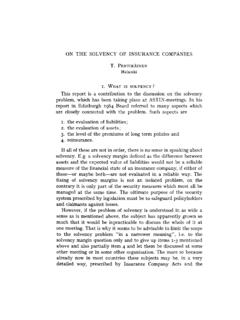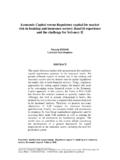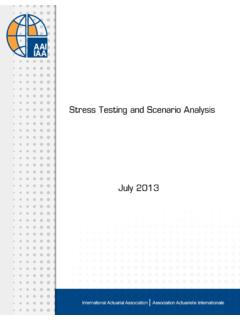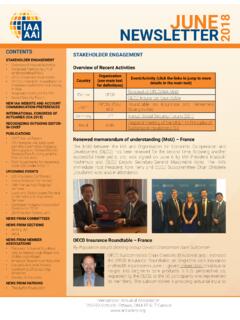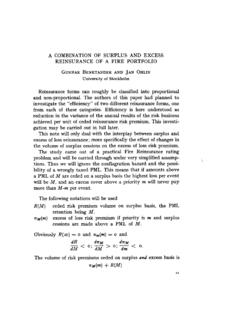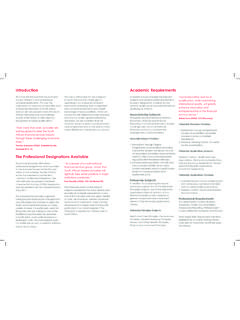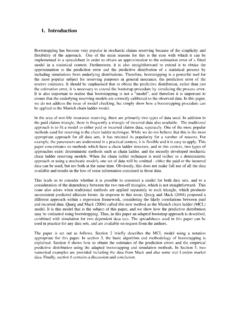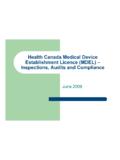Transcription of THE ROLE OF THE ACTUARY June 2013 - HOME (EN)
1 THE ROLE OF THE ACTUARY June 2013 International Actuarial Association Association Actuarielle Internationale 150 Metcalfe Street, Suite 601 Ottawa, Ontario Canada K2P 1P1 Tel: 1-613-236-0886 Fax: 1-613-236-1386 Email: 2013 International Actuarial Association / Association Actuarielle Internationale This paper has been produced by the Role of the ACTUARY Task Force of the Executive Committee (EC). The EC has adopted it as a generic document that can be used as written or adapted by member associations for use in their jurisdictions. The Role of the ACTUARY The Role of the ACTUARY 1 | P a g e Actuaries fulfill many roles in a broad range of environments, including insurance companies, health organizations, pension plans, risk management, government, regulatory regimes, and in other fields.
2 They have a detailed understanding of economic, financial, demographic and insurance risks and expertise in: developing and using statistical and financial models to inform financial decisions; pricing, establishing the amount of liabilities, and setting capital requirements for uncertain future events. Actuaries also provide advice on the adequacy of risk assessment, reinsurance arrangements, investment policies, capital levels and stress testing of the future financial condition of a financial institution. In this paper financial institution is used broadly to include pension plans and governmental systems, such as social insurance plans, as well as retail and investment banks. One of the key skills of an ACTUARY is the development and application of models to help solve complex financial problems.
3 This skill is now being applied successfully in many areas of business beyond the financial sphere. Actuaries add value to the raw output of a software model by using their professional judgment to assess and explain the practical implications of the results and the limitations of the model. The roles that actuaries perform are likely to vary over time, by country, practice area, relationship to the financial institution, corporate structure and culture. The appendix identifies roles currently undertaken by actuaries and highlights areas where actuaries could play a more prominent role in the future. Role of a Professional Actuarial Association The role of a professional actuarial association varies from country to country. However, most associations: create a credential that people in the actuarial field may earn, confirming that they have met high educational standards and are bound to high standards of professional conduct and practice, enforce professionalism requirements on qualified actuaries, further the science and art of actuarial practice, serve as the voice of the profession in the public interest when interacting with governments, the public, and other organizations, promote the profession to the public and users of actuarial services, both current and potential, and provide continuing professional development for their members.
4 The Role of the ACTUARY 2 | P a g e Although critical decisions may be made on the advice of an ACTUARY , in many countries the word ACTUARY is not a reserved term; that is, it is not defined in legislation or statute, nor is it reserved for individuals who are professionally qualified. This is in contrast to some other professions (for example, lawyers, doctors, architects, and dentists) which have titles reserved by law for qualified members, to protect their users. While users of actuarial services are typically not protected in that way, reliance on an ACTUARY holding a designation granted by a professional actuarial association can provide similar reassurance. Role of the International Actuarial Association The International Actuarial Association (IAA) provides guidelines for its member associations.
5 To become recognized as full members of the IAA, associations need to demonstrate that each of the following meets IAA guidelines: their educational system and requirements for membership, their code of professional conduct, their disciplinary process, and their system for developing standards of actuarial practice (if they have one). Once recognized as an IAA member, each association must continue to meet the IAA guidelines. These guidelines help assure that the individual actuaries who belong to full member associations also meet appropriate standards. The IAA cannot control the use of the term " ACTUARY ," but it can set professionalism guidelines for those who are members of IAA and is happy to assist both the local regulator and the local actuarial association wherever desired. Description of a Qualified ACTUARY A qualified ACTUARY is a professional trained in evaluating the current financial implications of future contingent events.
6 It is the ACTUARY s job to assist in the scientific analysis and quantification of risks. Expertise in understanding the underlying business dynamics, backed by training in economics, finance, demographics, statistics, and risk management, helps to ensure that actuaries build models which make best use of the available information. In general, actuaries excel in problem solving. Actuaries are equipped to help their clients and employers to make informed choices. The Role of the ACTUARY 3 | P a g e Actuaries work with financial and other institutions to measure, manage, and mitigate risks. Financial institutions accept risks (such as liabilities arising from death, auto accident, legal responsibility, outliving one s assets) from individuals or other companies for commercial reasons.
7 By pooling large numbers of these risks, the financial institution reduces, but does not eliminate, the variability of their total cost. Actuaries use statistical models and analysis to enhance their understanding of this variability and the risks inherent in the assets used to back these promises. In the context of insurance, for example, actuarial skills are used in establishing premiums, policy and claim liabilities, and appropriate capital levels. In other contexts, these skills are used to evaluate pension plan liabilities and determine the level of contributions required to finance pension, health care, and social insurance programs. Non-financial institutions can also benefit from the advice of actuaries. Role of Users of Actuarial Services The users of actuarial services can be reassured by the extent to which an ACTUARY has been trained and credentialed by a professional actuarial association and is subject to qualification standards, professional standards of practice, and obligations for professional conduct.
8 Employing a qualified ACTUARY can greatly strengthen a financial institution s risk and capital management, resulting in increased security of policyholders, shareholders and beneficiaries, to the benefit of the institution and its regulators. Analysis and projection of the finances of a social security program by a qualified ACTUARY can assist in the program s management by the government or other responsible agencies, and, where published, help inform a wider policy discussion. Appropriate involvement of qualified actuaries can help plan administrators to enhance the effectiveness of the plan management. Furthermore, appropriate involvement of qualified actuaries can help supervisors enhance the effectiveness of the regulatory process. Supervisors and other users of actuarial services are encouraged to work with the IAA member associations to determine the appropriate functions for qualified actuaries providing professional services in their jurisdictions.
9 The Role of the ACTUARY 4 | P a g e APPENDIX roles (a non-exhaustive list) typically filled by actuaries currently include: a. Life and general insurance Establishing estimates for unpaid claim liabilities, unearned premium and other estimated liabilities (technical reserves) and certifications Insurance product premium pricing Surrender value calculations Management of pooled savings products, such as with profits Reinsurance program design and management Underwriting policy definitions Life groups underwriting Solvency calculations and reports Internal modeling, including stochastic asset-liability modeling Strategic asset management and capital management Value management (embedded value) Corporate strategy and planning and control management, including mergers and acquisitions b. Health insurance, public health and healthcare management i.
10 Topics that apply to all lines Product development, pricing, product management, premium adjustments, marketing and competition studies from all stakeholder s perspectives Underwriting and reinsurance Modeling, profit testing, reserving (including with-profit attributions), solvency calculations. embedded value, financial forecasts and controls Catastrophic claim, reinsurance, stop-loss insurance and high-risk pool analysis Calculation of reserve for long term guarantee provisions Calculation of implicit debt ii. Topics that are health specific Health utilization, benchmarking and cost trend forecasts Health risk status analysis and revenue risk adjustment Disease management return on investment and predictive modeling medical provider reimbursement analysis, including provider capitation, financial incentives and episode payments The Role of the ACTUARY 5 | P a g e Population disease prevalence forecasts medical device, pharmacy and new technology efficiency studies Behavior change studies related to health issues Wellness and preventive care impact studies Evidence based treatment protocols c.
